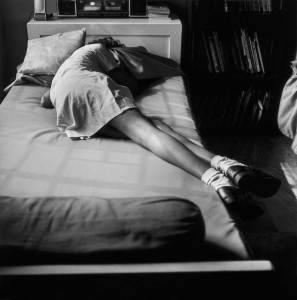
Go Away Closer (detail from a series; 2007), Dayanita Singh Courtesy the artist and Frith Street Gallery, London © the artist 2013
‘The form of the book,’ says Dayanita Singh, ‘is a very intimate form. To me, it’s the best way to look at photography.’ This is quite a provocative statement with which to mark your first UK retrospective exhibition ‘Go Away Closer’ at the Hayward Gallery. But it’s instructive, because this distinction between two ways of engaging with art – printed page and physical exhibition – has underpinned much of Singh’s work since she made her name photographing tabla player Zakir Hussain in the 1980s. It’s also a distinction that provides a timely contribution to recent discussions around the role of the curator.
The exhibition’s central thrust is that, for Singh, the photographic image is not an end in itself. Rather it seems to be a starting point for a process of editing and curating. Through repetition and reproduction, every image comes to have its own history.

File Museum (detail from a series; 2012), Dayanita Singh Courtesy the artist and Frith Street Gallery, London © the artist, 2013
This is perhaps most evident in File Room, a series of black and white images depicting small-scale archiving systems across India, each with their own individual system of organisation, each apparently impenetrable and always on the brink of disintegration. I first came across this series at the 2011 Venice Biennale, but archived here in the form of mute-toned, cloth-bound books – then mounted on the wall or inlaid into a librarian’s book cart – the images benefit from a wry kind of self-reflexivity.
Such re-contextualisation is a repeated motif. Two walls of the exhibition consist of photographs from past series, revisited and hung together like this for the first time. One particular image – of a young girl lying on her bed, concealing her head under the sheets – occurs at least three times across the exhibition, as well as in the accompanying book. Elsewhere, series titles are conveyed by the wall-mounting of the book itself. Myself Mona Ahmed – a long-running portrait of a eunuch who became her closest friend – is supplemented by an open book, the two visible pages providing the perfect hint of context. More copies are laid out on a shelf by a window, for visitors to flick through.

Go Away Closer (detail from a series; 2007), Dayanita Singh Courtesy the artist and Frith Street Gallery, London © the artist, 2013
At the beating heart of this exhibition is Museum Bhavan. Looking back into Singh’s personal archive – which includes her own photographs and those, in particular, of her mother – this is a project of richness, intelligence and poignancy. But, as all archives must do, it also looks forwards, and there are plans for Museum Bhavan to travel to public institutions and private abodes, with an archivist-in-residence, boards of trustees, and all the accoutrement of archival administration.
It’s also an absolute delight to explore. Images have been grouped by theme – Chance, Vitrines, Embraces etc. – and each group forms its own individual museum, housed in specially made cabinets. The honeyed hum of teak’s natural oils provides a background note to the joys of exploring this strange, idiosyncratic museum: squeezing through gaps, standing on tip-toes, poking your head into crevices, just to catch a glimpse of an image, barely there in the dim light.
But there is a limit. Despite the tantalising proximity of these filing systems, and the resulting desire to pull out a drawer or open one of the elegant little boxes, such an act is understood, here, in an art gallery, to be prohibited. Unlike the book, engagement takes place only within a specifically proscribed set of rules. More glaring is the inescapable irony of the signage: ‘NO PHOTOGRAPHY’ it asserts, in unambiguous caps.
Such controls are curatorial in the strictest sense – they exist in order to protect the works on show. Chatting briefly to the artist at the morning media view, I asked whether I was able to open one of the files myself. The answer, of course, was no. ‘Unless,’ she said, ‘you have the museum in your home. Then you are the curator.’
‘Dayanita Singh: Go Away Closer’ is at the Hayward Gallery, London until 15 December 2013.
Dayanita Singh: Go Away Closer is published by Hayward Publishing and can be purchased in the Southbank Centre Shop (special exhibition price £9.99; RRP £12.99)

Catalogue Photography
Go Away Closer (detail from a series; 2007), Dayanita Singh Courtesy the artist and Frith Street Gallery, London © the artist 2013
Share
Go Away Closer (detail from a series; 2007), Dayanita Singh Courtesy the artist and Frith Street Gallery, London © the artist 2013
‘The form of the book,’ says Dayanita Singh, ‘is a very intimate form. To me, it’s the best way to look at photography.’ This is quite a provocative statement with which to mark your first UK retrospective exhibition ‘Go Away Closer’ at the Hayward Gallery. But it’s instructive, because this distinction between two ways of engaging with art – printed page and physical exhibition – has underpinned much of Singh’s work since she made her name photographing tabla player Zakir Hussain in the 1980s. It’s also a distinction that provides a timely contribution to recent discussions around the role of the curator.
The exhibition’s central thrust is that, for Singh, the photographic image is not an end in itself. Rather it seems to be a starting point for a process of editing and curating. Through repetition and reproduction, every image comes to have its own history.
File Museum (detail from a series; 2012), Dayanita Singh Courtesy the artist and Frith Street Gallery, London © the artist, 2013
This is perhaps most evident in File Room, a series of black and white images depicting small-scale archiving systems across India, each with their own individual system of organisation, each apparently impenetrable and always on the brink of disintegration. I first came across this series at the 2011 Venice Biennale, but archived here in the form of mute-toned, cloth-bound books – then mounted on the wall or inlaid into a librarian’s book cart – the images benefit from a wry kind of self-reflexivity.
Such re-contextualisation is a repeated motif. Two walls of the exhibition consist of photographs from past series, revisited and hung together like this for the first time. One particular image – of a young girl lying on her bed, concealing her head under the sheets – occurs at least three times across the exhibition, as well as in the accompanying book. Elsewhere, series titles are conveyed by the wall-mounting of the book itself. Myself Mona Ahmed – a long-running portrait of a eunuch who became her closest friend – is supplemented by an open book, the two visible pages providing the perfect hint of context. More copies are laid out on a shelf by a window, for visitors to flick through.
Go Away Closer (detail from a series; 2007), Dayanita Singh Courtesy the artist and Frith Street Gallery, London © the artist, 2013
At the beating heart of this exhibition is Museum Bhavan. Looking back into Singh’s personal archive – which includes her own photographs and those, in particular, of her mother – this is a project of richness, intelligence and poignancy. But, as all archives must do, it also looks forwards, and there are plans for Museum Bhavan to travel to public institutions and private abodes, with an archivist-in-residence, boards of trustees, and all the accoutrement of archival administration.
It’s also an absolute delight to explore. Images have been grouped by theme – Chance, Vitrines, Embraces etc. – and each group forms its own individual museum, housed in specially made cabinets. The honeyed hum of teak’s natural oils provides a background note to the joys of exploring this strange, idiosyncratic museum: squeezing through gaps, standing on tip-toes, poking your head into crevices, just to catch a glimpse of an image, barely there in the dim light.
But there is a limit. Despite the tantalising proximity of these filing systems, and the resulting desire to pull out a drawer or open one of the elegant little boxes, such an act is understood, here, in an art gallery, to be prohibited. Unlike the book, engagement takes place only within a specifically proscribed set of rules. More glaring is the inescapable irony of the signage: ‘NO PHOTOGRAPHY’ it asserts, in unambiguous caps.
Such controls are curatorial in the strictest sense – they exist in order to protect the works on show. Chatting briefly to the artist at the morning media view, I asked whether I was able to open one of the files myself. The answer, of course, was no. ‘Unless,’ she said, ‘you have the museum in your home. Then you are the curator.’
‘Dayanita Singh: Go Away Closer’ is at the Hayward Gallery, London until 15 December 2013.
Dayanita Singh: Go Away Closer is published by Hayward Publishing and can be purchased in the Southbank Centre Shop (special exhibition price £9.99; RRP £12.99)
Unlimited access from just $16 every 3 months
Subscribe to get unlimited and exclusive access to the top art stories, interviews and exhibition reviews.
Share
Recommended for you
Frida y…
Frida Kahlo and Diego Rivera make awkward companions at a nonetheless important Paris exhibition
Small Wonders: Abbot Hall
Helen Watson, director of exhibitions and collections at the Abbot Hall Art Gallery, speaks to Apollo
First Look: Facing the Modern
Gemma Blackshaw, guest curator of ‘Facing the Modern: the Portrait in Vienna 1900’ at the National Gallery in London, speaks to Apollo